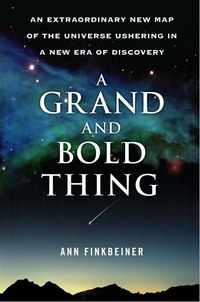Review: A Grand and Bold Thingby Jeff Foust
|
| “Most Sloanies weren’t sure what a project manager was; management wasn’t something astronomy projects needed, the partners just went off and did what they were good at,” she writes. |
The concept behind the Sloan Digital Sky Survey (usually called just Sloan) dates makes back more than 20 years, to an idea by Princeton astronomer Jim Gunn. Building upon his experience developing instruments using the then-new technology of CCDs (including one of the original cameras on the Hubble Space Telescope), he proposed developing an advanced camera mounted on a modest-sized telescope to perform the most extensive and detailed survey yet of the night sky. Gunn had a simple goal in mind: detect one million galaxies, enough to do rigorous analysis of their types and positions. Building the Sloan, though, would turn out to be far from simple.
A Grand and Bold Thing, while discussing much of the science associated with the telescope, devotes much, if not more, of the book to the struggles building it. The project was something of a grassroots, bottom-up effort, with Gunn and other proponents eventually building up a consortium that included several universities as well as Fermilab to build the telescope and its instruments. Over time, though, as the project—and its cost—grew, and its schedule stretched out, this relatively loosely-run consortium showed stresses that eventually put the project in jeopardy.
The problem, Finkbeiner notes, was that the project had outgrown the small scopes that astronomers were comfortable with managing in their informal ways, and they were slow to adopt more rigorous project management methodologies used on bigger projects, such as NASA missions. “Most Sloanies”—the term used for those working on the project—“weren’t sure what a project manager was; management wasn’t something astronomy projects needed, the partners just went off and did what they were good at,” she writes. Eventually the Sloanies did learn to appreciate the importance of project management, which perhaps saved the project from cancellation.
| Sloan has helped enable “virtual observatories” thatare becoming a standard means of doing research for young astronomers, who will search them for data often in lieu of doing observations themselves. |
Another interesting theme in the book is how information technology, from ever more powerful computers to the ability to make vast archives of data available to anyone with Internet access, is reshaping how astronomy is done. Sloan, Finkbeiner writes, was among the first projects to significantly involve so-called “astrocoders”—astronomers who specialize in writing code that analyzes astronomical data—to develop the software essential to collecting and processing the huge volume of data the telescope’s instruments would collect. Sloan observations are freely available in an online archive, which has allowed many astronomers not involved in the project to make use of the data for their own research on everything from distant quasars to main belt asteroids. As of last October, the book notes, 2,656 papers had been based on Sloan data.
That greater accessibility of data, the book notes, is changing how astronomers work. Wayne van Citters of the NSF describes how such “virtual observatories” are becoming a standard means of doing research for young astronomers, who will search them for data often in lieu of doing observations themselves. “And if it means that they don’t go to the telescope,” he says, “they think, Well, OK, so I don’t have to go to the telescope.” The volume and accessibility of the data has also opened up opportunities for citizen science, such as the Galaxy Zoo program, where ordinary people viewed and classified galaxies in Sloan observations, an effort that has attacted hundreds of thousands of participants making tens of millions of classifications.
A Grand and Bold Thing does a good job examining the history of the Sloan Digital Sky Survey from the perspective of those who were involved in the long, arduous, but ultimately very successful project. (One shortcoming of the book is the lack of photos of any kind, not just Sloan imagery but also of the telescope itself and the key people involved in its development, an unusual omission for an astronomy book but fortunately not a critical one here.) Ironically, as the book points out at the end, even though the Sloan has enabled the research of many astronomers both inside and outside the project, one person who hasn’t used it is Gunn himself. While winning numerous awards and speaking out on the importance of recognizing the contributions of astrocoders and instrument developers in the field, he’s been too busy helping develop the Sloan to actually do the science. And, he tells Finkbeiner, he’s fine with that: “I’ve managed to work that around in my head in a way—it wasn’t a conscious thing—that I can just feel fatherly about this.” What he’s fathered, as this book illustrates, is a project that hasn’t garnered much public attention yet has revolutionized astronomy.
